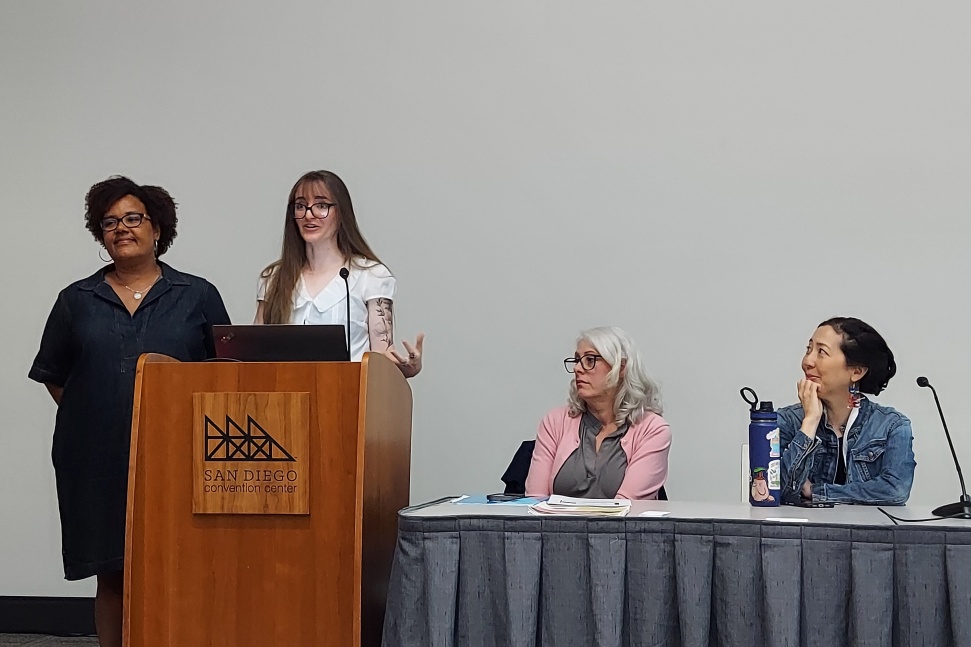
In 2019, the number of students being homeschooled was 2.5 million. By 2022, that figure was up to 3.1 million students, according to the National Home Education Research Institute.
“Across the nation, there’s been a significant increase, with New York State and California among the highest,” said Deborah Hempe, coordinator for outreach services at Middle Country Public Library (MCPL) in Centereach, New York.
Public libraries can be a place that meets the educational and social needs of this growing demographic, said Hempe and her fellow presenters at “Building Homeschooling Resources and Community Relationships at the Public Library,” a July 1 session at the American Library Association’s 2024 Annual Conference and Exhibition in San Diego.
Families that choose homeschooling do so for a variety of reasons, Hempe said, including a desire to provide moral or religious instruction, concerns over bullying and school shootings, a desire to provide nontraditional education, and the belief that COVID-19 restrictions are too strict—or not strict enough.
Using a $15,000 grant from the Long Island Community Foundation, MCPL started its Education Resource Center for homeschoolers back in 2014. The center comprises both collection items (such as microscopes, chemistry sets, nature backpacks, American Girl dolls, online databases, and suggested periodicals) as well as programming, like its popular Homeschooling 101 session that outlines legal requirements and how families might want to structure their homeschooling.
“We did not really focus spending that money on curriculum,” said Hempe, who notes that textbooks are expensive and go out of date quickly.
San Diego Public Library (SDPL) also chose not to spend its funds on curriculum materials when starting the Homeschool Resource Center at its Mission Valley branch during the COVID-19 pandemic, said Marika Jeffery, SDPL youth services manager. Instead, SDPL focused on building connections with homeschooling charter networks and libraries that had undertaken similar projects. (In California, Jeffery noted, homeschoolers can enroll in a charter school where the parent is the primary teacher but still has access to a credentialed teacher.)
“They are a huge part of how we get the word out,” Jeffery said of the charter networks, as well as homeschooling businesses, nonprofits, local co-ops, and Facebook groups.
The center at SDPL offers technology tools and a space to gather, as well as robust programming for homeschooling families, including career events for teens and free instruction from the San Diego Weavers Guild. “I regularly receive thank-yous and kudos from homeschooling parents,” Jeffery said. “We’re the only homeschooling resource center that we know of in San Diego County.”
While SDPL was able to secure a $52,000 grant from the Library Services Technology Act, staffers from Contra Costa County (Calif.) Library (CCCL) stressed that a library doesn’t need that level of funding to start a homeschooling resource center. “We got started less than a year ago,” said Alison M. Peters, senior community library manager at CCCL. “It is a big idea with a small budget.”
Peters runs the Homeschool Resource Center at the Hercules branch—which was funded for about $2,000 with help from CCCL’s Friends group and foundation—alongside librarian Katy Buder. After conducting focus groups with homeschooling families, Peters and Buder decided to prioritize a study space that is open from 10 a.m. to 2 p.m. on weekdays and opportunities for children and teens to meet and socialize based on age and interest. The center has hosted such events as DIY bookmaking, sewing classes, and a spooky story writing workshop.
Buder said CCCL’s center is about “creating that community, making those organic connections, and letting [the families] run with it.”
Peters noted that the homeschooling families who use the center have gotten close, with some sharing childcare and transportation. “It’s feeling like this wonderful family, and that’s one of the best parts.”
The librarians who manage these homeschooling resource centers say the families who use them are extremely grateful to have them nearby. Said Jeffery: “I feel like we’re creating some wonderful community we really hadn’t tapped into before.”

